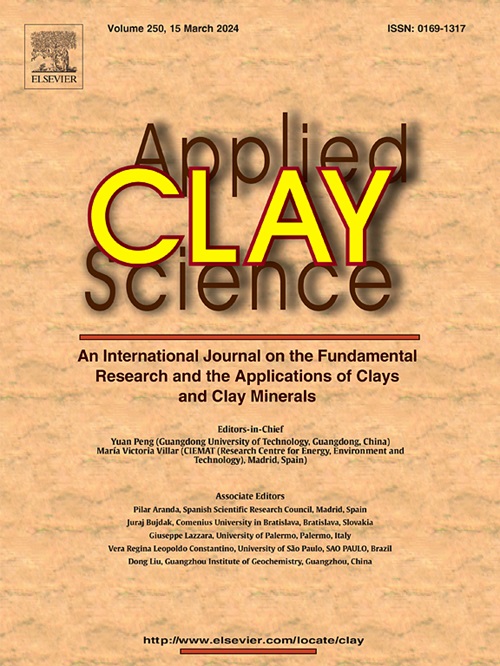Yeast-activated carbon/montmorillonite nanosheets with porous spherical shells for efficient tetracycline degradation
IF 5.3
2区 地球科学
Q2 CHEMISTRY, PHYSICAL
引用次数: 0
Abstract
A bio-derived carbon composite catalyst was successfully prepared by loading yeast onto the assembled montmorillonite nanosheets (MMTNS-L), followed by calcination, which effectively prevented catalyst aggregation. MMTNS assembled in a two-dimensional direction to form large sheets, providing a robust support structure. After carbonization, yeast cells, as natural biological entities rich in nitrogen, exhibited a distinctive hollow thin-layer spherical shell with a large specific surface area and abundant pores. The evaporation of internal water vapor further contributed to the formation of this porous structure. The spherical shells uniformly distribute on the assembled MMTNs, resisting aggregation and exposing more active sites, which enhances the catalyst's efficiency. The pyridine N and pyrrole N formed after carbonization provide additional active sites to facilitate electron transfer, while the stable graphite N and N![]() O enhance the catalyst's stability and promote the non-radicals generation. During the degradation process, potassium peroxymonosulfate (PMS) was introduced and activated by the catalyst, generating both free and non-free radicals to effectively degrade tetracycline (TC). Under optimal conditions, the assembly of MMTNS with a lamellar structure, followed by high-temperature yeast carbonization, achieved an 84 % TC degradation rate within 15 min. In this process, , , and 1O2 all participated in TC degradation, with 1O2 being the dominant reactive species. As a highly reactive non-radical, 1O2 interacts with organic matter to facilitate its degradation. This structure significantly enhances photocatalytic performance and shows great potential for antibiotic removal. This technique aims to enhance the exposure of active sites on carbonized yeast and improve the catalyst's stability, thereby supporting the efficient treatment of antibiotic wastewater and the application of biocarbon catalytic materials.
O enhance the catalyst's stability and promote the non-radicals generation. During the degradation process, potassium peroxymonosulfate (PMS) was introduced and activated by the catalyst, generating both free and non-free radicals to effectively degrade tetracycline (TC). Under optimal conditions, the assembly of MMTNS with a lamellar structure, followed by high-temperature yeast carbonization, achieved an 84 % TC degradation rate within 15 min. In this process, , , and 1O2 all participated in TC degradation, with 1O2 being the dominant reactive species. As a highly reactive non-radical, 1O2 interacts with organic matter to facilitate its degradation. This structure significantly enhances photocatalytic performance and shows great potential for antibiotic removal. This technique aims to enhance the exposure of active sites on carbonized yeast and improve the catalyst's stability, thereby supporting the efficient treatment of antibiotic wastewater and the application of biocarbon catalytic materials.

多孔球壳酵母活性炭/蒙脱土纳米片对四环素的高效降解
通过将酵母加载到组装好的蒙脱土纳米片(MMTNS-L)上,然后进行煅烧,成功制备了生物源碳复合催化剂,有效地防止了催化剂的聚集。MMTNS在二维方向上组装形成大片,提供坚固的支撑结构。酵母细胞作为富含氮的天然生物实体,碳化后呈现出独特的空心薄层球壳,具有较大的比表面积和丰富的孔隙。内部水蒸气的蒸发进一步促进了这种多孔结构的形成。球形壳均匀分布在组装的mmtn上,抵抗聚集,暴露出更多的活性位点,提高了催化剂的效率。炭化后形成的吡啶N和吡咯N为电子转移提供了额外的活性位点,而稳定的石墨N和NO则增强了催化剂的稳定性,促进了非自由基的生成。在降解过程中,引入过氧单硫酸氢钾(PMS)并被催化剂激活,生成自由基和非自由基,有效降解四环素(TC)。在最佳条件下,将MMTNS组装成片层结构,然后进行高温酵母碳化,在15 min内实现了84%的TC降解率。在此过程中,•SO4 -、•O2 -和1O2都参与了TC的降解,其中1O2是主要的反应物质。作为一种高活性的非自由基,1O2与有机物相互作用,促进有机物降解。该结构显著提高了光催化性能,具有很大的去除抗生素的潜力。该技术旨在增加炭化酵母上活性位点的暴露,提高催化剂的稳定性,从而支持抗生素废水的高效处理和生物碳催化材料的应用。
本文章由计算机程序翻译,如有差异,请以英文原文为准。
求助全文
约1分钟内获得全文
求助全文
来源期刊

Applied Clay Science
地学-矿物学
CiteScore
10.30
自引率
10.70%
发文量
289
审稿时长
39 days
期刊介绍:
Applied Clay Science aims to be an international journal attracting high quality scientific papers on clays and clay minerals, including research papers, reviews, and technical notes. The journal covers typical subjects of Fundamental and Applied Clay Science such as:
• Synthesis and purification
• Structural, crystallographic and mineralogical properties of clays and clay minerals
• Thermal properties of clays and clay minerals
• Physico-chemical properties including i) surface and interface properties; ii) thermodynamic properties; iii) mechanical properties
• Interaction with water, with polar and apolar molecules
• Colloidal properties and rheology
• Adsorption, Intercalation, Ionic exchange
• Genesis and deposits of clay minerals
• Geology and geochemistry of clays
• Modification of clays and clay minerals properties by thermal and physical treatments
• Modification by chemical treatments with organic and inorganic molecules(organoclays, pillared clays)
• Modification by biological microorganisms. etc...
 求助内容:
求助内容: 应助结果提醒方式:
应助结果提醒方式:


